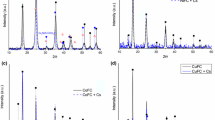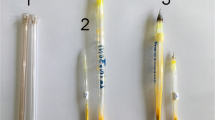Abstract
The cesium (Cs) adsorption ability and stability of metal hexacyanoferrates (MHCFs: M = Fe, Cu, Ni) in HNO3 solutions were investigated as a function of the absorbed dose resulting from irradiation with gamma rays.
Similar content being viewed by others
Explore related subjects
Discover the latest articles, news and stories from top researchers in related subjects.Avoid common mistakes on your manuscript.
Introduction
In the nuclear industry, one of the most important tasks is safe management of the high-level radioactive waste (HLW) generated during the reprocessing of spent fuels. It is expected that by removing cesium (Cs) from HLWs, the volume of vitrified wastes can be reduced because the amount of HLWs that can be safely contained by vitrified wastes intended for disposal is limited by the decay heats of nuclides such as 137Cs and 90Sr [1]. In addition, the handling of HLWs with a reduced Cs content should be easier, because the bulk of the radioactivity of HLWs derives from 137Cs and 90Sr for several hundreds of years following the reprocessing of spent fuels [2].
Metal hexacyanoferrates (MHCFs: M = Fe, Cu or Ni) are known as adsorbents for the selective adsorption of Cs ions in solution [3]. Recently, we reported an electrochemical method based on MHCFs for Cs recovery from nitric acid (HNO3) solutions [4, 5]. In the separation system, the adsorption/desorption of Cs ions was conducted repeatedly on an electrode coated with MHCF nanoparticles. Thus far, we have revealed that synthesized FeHCF, obtained as the charge-compensated salt (Fe III4 [FeII(CN)6]3), has a much higher Cs adsorption ability than that of commercially purchased FeHCF (Prussian blue) with an ideal perfect lattice, although the intrinsic mechanism of selective Cs ion adsorption has not yet been clarified. The greater ability is attributed to the presence of lattice defect sites [6].
In this study, the influence of the gamma ray irradiation of MHCFs with lattice defect sites on their Cs adsorption ability and stability in HNO3 solutions was investigated for MHCF application in practical Cs separation processes.
Experimental
Materials
The metal hexacyanoferrates used in this study were synthesized according to the previously reported procedure [7, 8] and included Fe III4 [FeII(CN)6]3 (FeHCF), Cu II3 [FeIII(CN)6]2 (CuHCF), and Ni II3 [FeIII(CN)6]2 (NiHCF). All other chemicals were of analytical reagent grade.
Gamma ray irradiation
Irradiation with gamma rays was conducted at the 60Co gamma ray irradiation facilities at the Takasaki Advanced Radiation Research Institute of the Japan Atomic Energy Agency (JAEA). Two types of samples were prepared for irradiation: only MHCF (dry-irradiation sample) and MHCF in 1.0 M HNO3 solution (wet-irradiation sample). Samples in glass tubes were intermittently irradiated with gamma rays from a 1.0 × 1016 Bq 60Co source at an absorbed dose rate of 10 kGy h−1 in air at room temperature for a maximum of 27 h. The dose absorbed by each sample was corrected for the electron density. The absorbed doses were calibrated using a cellulose triacetate film dosimeter.
Adsorption of cesium by the MHCFs
Batch adsorption experiments were performed to determine the Cs distribution coefficients (K d) for the irradiated MHCFs. For the wet-irradiation samples, each MHCF was separated from the irradiated mixture by filtration and then dried under vacuum before the adsorption experiments. Next, the irradiated MHCF (50 mg) was contacted with 1.0 M HNO3 (2 ml) containing 1 ppm Cs at room temperature for 1 h. After centrifugation and separation, the concentration of Cs in the aqueous phase was measured using inductively coupled plasma mass spectroscopy (ICP-MS, NexIon300 D, PerkinElmer, USA). The K d was calculated using Eq. (1):
where C 0 and C are the concentrations of Cs in the aqueous phase before and after adsorption, respectively, V S is the volume of the aqueous phase (ml), and W R is the weight of the dry adsorbent (g).
Evaluation of the radiolytic decomposition of the MHCFs
To evaluate the radiolytic decomposition of the MHCFs, the ratio of the dissolved M (= Fe, Cu or Ni) in the aqueous phase to the initial weight of each MHCF was calculated using the amount of M determined via ICP-MS analysis after irradiation. In addition, elemental analysis for C, H, and N was performed after irradiation using an Amco EA1110 elemental analyzer.
Results and discussion
Cesium adsorption ability of the MHCFs
The Cs distribution coefficients (K d) for the MHCFs are shown in Fig. 1 as a function of the adsorbed dose. Without irradiation, the K d value for each MHCF reached the maximum, and all of the MHCFs exhibited high selectivity for Cs. Furthermore, in the absorbed dose range from 0 to 300 kGy, each K d was nearly constant and independent of the absorbed dose under both dry- and wet-irradiation conditions, although CuHCF exhibited a two-order smaller K d compared to those of FeHCF and NiHCF. In addition, the K d values for FeHCF and CuHCF under wet-irradiation conditions were less than the corresponding values under dry-irradiation conditions. This decrease in the K d in HNO3 solution may be due to the reaction of the MHCFs with radicals generated during the radiolytic decomposition of H2O and HNO3. However, despite the lower K d values, no appreciable depreciation in the adsorption ability following irradiation was observed.
Stability of the MHCFs
The ratios of the quantities of each M (= Fe, Cu or Ni) dissolved in the HNO3 solutions following irradiation to the initial weights of the corresponding MHCFs are shown in Fig. 2 as a function of the adsorbed dose. As observed in the figure, in the absorbed dose range from 0 to 300 kGy, the dissolved concentrations of all of the metal ions increased with an increase in the absorbed dose. This result suggests the radiolysis of the MHCFs by gamma rays. Notably, the Fe in FeHCF was dissolved 10 times more readily than the Cu and Ni in CuHCF and NiHCF, respectively, regardless of the absorbed gamma ray dose. On the other hand, the dissolution of Ni from NiHCF was approximately three times greater than that of Cu from CuHCF. This difference in the dissolution of the metal from CuHCF and NiHCF may be attributed to the ionization tendencies of Cu and Ni. Based on the dissolution behavior of the metal ions after irradiation, it appears that CuHCF was the most stable with respect to gamma ray irradiation, but exhibited the lowest K d(Cs) values.
It should also be noted that, although the dissolution of the metal ions increased with an increase in the gamma ray dose, the K d(Cs) were nearly constant regardless of the dose, as shown in Figs. 1 and 2. We previously reported that the sites around lattice defects play an important role in the uptake of cesium by MHCFs. These results are consistent with this conclusion, because the constant K d(Cs) values suggest that the quantity of sites where uptake occurred where caused by dissolution of metal ions from the MHCFs.
As observed in Fig. 3, the elemental analysis results for the irradiated MHCFs indicated that no deterioration in the carbon, hydrogen, and nitrogen content occurred at any of the gamma ray doses.
Conclusion
To determine the applicability of metal hexacyanoferrates (MHCFs: M = Fe, Cu, Ni) in practical Cs separation processes, the adsorption ability for Cs and the stability of various MHCFs in HNO3 solutions were investigated as a function of the absorbed dose resulting from irradiation with gamma rays. The Cs distribution coefficients for the irradiated MHCFs were nearly constant and independent of the absorbed dose (0–300 kGy). In addition, in this absorbed dose range, the dissolution of M due to irradiation with gamma rays was found to be negligible. In conclusion, it was revealed that the retention of the adsorption ability was attributed to the stability of the MHCFs.
References
International Atomic Energy Agency (1985) Chemical durability and related properties of solidified high-level waste forms. Technical reports series 257
Croff AG (1983) Nucl Technol 62:335
International Atomic Energy Agency (1992) Chemical precipitation processes for the treatment of aqueous radioactive waste. Technical reports series 337
Chen R, Tanaka H, Kawamoto T, Asai M, Fukushima C, Kurihara M, Watanabe M, Arisaka M, Nankawa T (2012) Preparation of a film of copper hexacyanoferrate nanoparticles for electrochemical removal of cesium from radioactive wastewater. Electrochem Commun 25:23–25
Chen R, Tanaka H, Kawamoto T, Asai M, Fukushima C, Na H, Kurihara M, Watanabe M, Arisaka M, Nankawa T (2013) Selective removal of cesium ions from wastewater using copper hexacyanoferrate nanofilms in an electrochemical system. Electrochim Acta 87:119–125
Ishizaki M, Akiba S, Ohtani A, Hoshi Y, Ono K, Matsuba M, Togashi T, Kananizuka K, Sakamoto M, Takahashi A, Kawamoto T, Tanaka H, Watanabe M, Arisaka M, Nankawa T, Kurihara M (2013) Proton-exchange mechanism of specific Cs+ adsorption via lattice defect sites of Prussian blue filled with coordination and crystallization water molecules. Dalton Trans 42:16049–16055
Gotoh A, Uchida H, Ishizaki M, Satoh T, Kaga S, Okamoto S, Ohta M, Sakamoto M, Kawamoto T, Tanaka H, Tokumoto M, Hara S, Shiozaki H, Yamada M, Miyake M, Kurihara M (2007) Simple synthesis of three primary color nanoparticle inks of Prussian blue and its analogues. Nanotechnology 18:345609
Ishizaki M, Sakamoto M, Tanaka H, Kawamoto T, Kurihara M (2011) Synthesis of water-dispersible copper hexacyanoferrate nanoparticles and electrochromism of the thin films. Mol Cryst Liq Cryst 539(1):18–22
Acknowledgments
The present study includes the results for the project “Compact and reusable cesium recovery system by electrochemical adsorption/desorption” entrusted to the Japan Atomic Energy Association (JAEA) and AIST by the Japan Science and Technology Agency (JST).
Author information
Authors and Affiliations
Corresponding author
Rights and permissions
About this article
Cite this article
Arisaka, M., Watanabe, M., Ishizaki, M. et al. Cesium adsorption ability and stability of metal hexacyanoferrates irradiated with gamma rays. J Radioanal Nucl Chem 303, 1543–1547 (2015). https://doi.org/10.1007/s10967-014-3710-0
Received:
Published:
Issue Date:
DOI: https://doi.org/10.1007/s10967-014-3710-0







